STS-51A
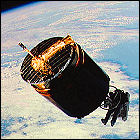 Space Shuttle Discovery takes off on a week-long satellite deployment mission, delivering a Canadian communications satellite and another American SYNCOM defense communications satellite into orbit. Using the MMU jet packs, Discovery’s crew retrieve two satellites placed into the wrong orbits by malfunctioning boosters after a shuttle mission earlier in the year, returning them to the cargo bay for return to Earth. Discovery’s crew consists of Commander Frederick Hauck, Pilot David Walker, and mission specialists Anna Fisher, Dale Gardner, and Joseph Allen.
Space Shuttle Discovery takes off on a week-long satellite deployment mission, delivering a Canadian communications satellite and another American SYNCOM defense communications satellite into orbit. Using the MMU jet packs, Discovery’s crew retrieve two satellites placed into the wrong orbits by malfunctioning boosters after a shuttle mission earlier in the year, returning them to the cargo bay for return to Earth. Discovery’s crew consists of Commander Frederick Hauck, Pilot David Walker, and mission specialists Anna Fisher, Dale Gardner, and Joseph Allen.
STS-41G
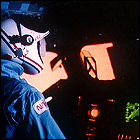 Space Shuttle Challenger lifts off on an eight-day mission, the first shuttle mission with a seven-person crew, which also happens to be the first American shuttle crew with two women on board. A satellite to study radiation around the Earth is deployed, along with an experiment to study the feasibility of refueling empty satellites to extend their service life. Challenger’s crew for this flight consists of Commander Robert Crippen, Pilot Jon McBride, mission specialists Kathryn Sullivan, Sally Ride, David Leestma and payload specialists Marc Garneau and Paul Scully-Power.
Space Shuttle Challenger lifts off on an eight-day mission, the first shuttle mission with a seven-person crew, which also happens to be the first American shuttle crew with two women on board. A satellite to study radiation around the Earth is deployed, along with an experiment to study the feasibility of refueling empty satellites to extend their service life. Challenger’s crew for this flight consists of Commander Robert Crippen, Pilot Jon McBride, mission specialists Kathryn Sullivan, Sally Ride, David Leestma and payload specialists Marc Garneau and Paul Scully-Power.
STS-41D: Discovery’s debut
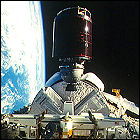 Space Shuttle Discovery makes its first flight into space on a mission to deploy three commercial communications satellites. Tested on this flight is a huge solar power panel which unfolds vertically from Discovery’s cargo bay, testing technology for space station designs still on the drawing board. Discovery’s crew for this flight consists of Commander Henry Hartsfield, Pilot Michael Coats, mission specialists Judy Resnick, Steven Hawley, Mike Mullane, and payload specialist Charles Walker.
Space Shuttle Discovery makes its first flight into space on a mission to deploy three commercial communications satellites. Tested on this flight is a huge solar power panel which unfolds vertically from Discovery’s cargo bay, testing technology for space station designs still on the drawing board. Discovery’s crew for this flight consists of Commander Henry Hartsfield, Pilot Michael Coats, mission specialists Judy Resnick, Steven Hawley, Mike Mullane, and payload specialist Charles Walker.
Soyuz T-12
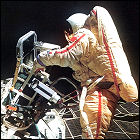 The Soviet Union launches Soyuz T-12 on a mission to space station Salyut 7. Cosmonauts Vladimir Dzhanibekov, Svetlana Savitskaya and Igor Volk visit the station crew and test new equipment during a three-hour spacewalk. Savitskaya becomes the first woman to fly in space twice as well as the first female spacewalker, an assignment that seems to have been devised purely for the political purpose of beating NASA to that first (the American space agency having announced in 1983 that an upcoming shuttle mission would feature a female spacewalker). Volk’s presence aboard the mission ensures that he has spaceflight experience ahead of his next mission, believed to be the first manned flight of the Soviet Buran shuttle. The Soyuz T-12 crew is in space for almost 12 days, returning to Earth on July 29th.
The Soviet Union launches Soyuz T-12 on a mission to space station Salyut 7. Cosmonauts Vladimir Dzhanibekov, Svetlana Savitskaya and Igor Volk visit the station crew and test new equipment during a three-hour spacewalk. Savitskaya becomes the first woman to fly in space twice as well as the first female spacewalker, an assignment that seems to have been devised purely for the political purpose of beating NASA to that first (the American space agency having announced in 1983 that an upcoming shuttle mission would feature a female spacewalker). Volk’s presence aboard the mission ensures that he has spaceflight experience ahead of his next mission, believed to be the first manned flight of the Soviet Buran shuttle. The Soyuz T-12 crew is in space for almost 12 days, returning to Earth on July 29th.
STS-41C
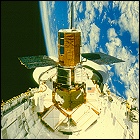 Space Shuttle Challenger lifts off on the first mission to retrieve a satellite in orbit, repair it, and release it back into that orbit. Launched in 1980, prior to the first shuttle mission, the Solar Maximum (Solar Max) Satellite is outfitted with a mechanism to allow the shuttle’s remote manipulator arm to grasp it; however, two astronauts using Manned Maneuvering Units still have to nudge it into Challenger’s cargo bay. With repairs completed, Solar Max is returned to its orbit, where it lasts until 1989. Challenger’s crew on this flight consists of Commander Bob Crippen, Pilot Francis Scobee, and mission specialists Geroge Nelson, James Van Hoften and Terry Hart.
Space Shuttle Challenger lifts off on the first mission to retrieve a satellite in orbit, repair it, and release it back into that orbit. Launched in 1980, prior to the first shuttle mission, the Solar Maximum (Solar Max) Satellite is outfitted with a mechanism to allow the shuttle’s remote manipulator arm to grasp it; however, two astronauts using Manned Maneuvering Units still have to nudge it into Challenger’s cargo bay. With repairs completed, Solar Max is returned to its orbit, where it lasts until 1989. Challenger’s crew on this flight consists of Commander Bob Crippen, Pilot Francis Scobee, and mission specialists Geroge Nelson, James Van Hoften and Terry Hart.
Soyuz T-11
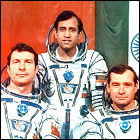 The Soviet Union launches Soyuz T-11 en route to space station Salyut 7. Spending nearly eight days in orbit, cosmonauts Yuri Malyshev, Gennady Strekalov and the first space traveler from India, Rakesh Sharma, perform experiments aboard the station as well as bringing supplies. They return to Earth on April 11th aboard the station crew’s Soyuz T-10 capsule, leaving the newer Soyuz T-11 docked at Salyut 7 for the station crew’s use.
The Soviet Union launches Soyuz T-11 en route to space station Salyut 7. Spending nearly eight days in orbit, cosmonauts Yuri Malyshev, Gennady Strekalov and the first space traveler from India, Rakesh Sharma, perform experiments aboard the station as well as bringing supplies. They return to Earth on April 11th aboard the station crew’s Soyuz T-10 capsule, leaving the newer Soyuz T-11 docked at Salyut 7 for the station crew’s use.
Soyuz T-10
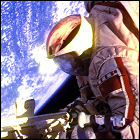 Delayed many months during the investigation into the causes of the Soyuz T-10a near-disaster in 1983, Soyuz T-10 lifts off from the Soviet Union. Cosmonauts Leonid Kizim, Vladimir Solovyov and Oleg Atkov take up residence on space station Salyut 7 for a 236-day stay – the longest duration crew of the entire Salyut space station program – during which they have to conduct repairs to the station both inside and outside in a series of spacewalks. Left unoccupied months longer than expected, the station has powered down and must be reactivated, a process taking nearly ten days. A fuel line break on the exterior of the station must be repaired as well. The crew remains aboard Salyut 7 through October.
Delayed many months during the investigation into the causes of the Soyuz T-10a near-disaster in 1983, Soyuz T-10 lifts off from the Soviet Union. Cosmonauts Leonid Kizim, Vladimir Solovyov and Oleg Atkov take up residence on space station Salyut 7 for a 236-day stay – the longest duration crew of the entire Salyut space station program – during which they have to conduct repairs to the station both inside and outside in a series of spacewalks. Left unoccupied months longer than expected, the station has powered down and must be reactivated, a process taking nearly ten days. A fuel line break on the exterior of the station must be repaired as well. The crew remains aboard Salyut 7 through October.
Manned Maneuvering Unit
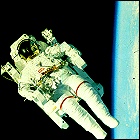 Astronaut Bruce McCandless becomes the first untethered human spacewalker when he leaves the cargo bay of Space Shuttle Challenger aboard a Manned Maneuvering Unit, a jetpack-like device allowing him to maneuver freely with no hoses or cables connecting him to the shuttle. In development since the Gemini era, and tested briefly aboard Skylab in prototype form, the MMU will see use on only three missions before NASA puts it in mothballs.
Astronaut Bruce McCandless becomes the first untethered human spacewalker when he leaves the cargo bay of Space Shuttle Challenger aboard a Manned Maneuvering Unit, a jetpack-like device allowing him to maneuver freely with no hoses or cables connecting him to the shuttle. In development since the Gemini era, and tested briefly aboard Skylab in prototype form, the MMU will see use on only three missions before NASA puts it in mothballs.
STS-41B
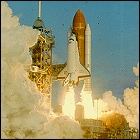 Space Shuttle Challenger lifts off on a satellite delivery mission, but the launches of both satellites go awry when their boosters (the Payload Assist Modules designed to launch satellites from the shuttle) put them in the wrong orbits. A German satellite is retrieved, repaired, and placed back into its orbit. A few days after launch, a member of Challenger’s crew will become the first free-floating human satellite. On this flight, Challenger’s crew consists of Commander Vance Brand, Pilot Robert Gibson, mission specialists Bruce McCandless, Ronald McNair and Robert Stewart. This is the first shuttle flight to end on the runway at Kennedy Space Center, eliminating the need for a costly, time-consuming 747 ferry flight to retrieve the shuttle from Edwards Air Force Base.
Space Shuttle Challenger lifts off on a satellite delivery mission, but the launches of both satellites go awry when their boosters (the Payload Assist Modules designed to launch satellites from the shuttle) put them in the wrong orbits. A German satellite is retrieved, repaired, and placed back into its orbit. A few days after launch, a member of Challenger’s crew will become the first free-floating human satellite. On this flight, Challenger’s crew consists of Commander Vance Brand, Pilot Robert Gibson, mission specialists Bruce McCandless, Ronald McNair and Robert Stewart. This is the first shuttle flight to end on the runway at Kennedy Space Center, eliminating the need for a costly, time-consuming 747 ferry flight to retrieve the shuttle from Edwards Air Force Base.
President Reagan commits to space station
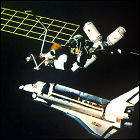 As part of his annual State of the Union address, President Ronald Reagan commits NASA’s resources to building a space station in Earth orbit using the unique space cargo delivery and construction/repair capabilities of NASA’s Space Shuttle fleet. The space agency draws up various plans for stations of varying sizes, ranging from not much bigger than the Apollo/Saturn-derived Skylab of the 1970s to an eventual proposal for a large, “dual keel” design that could become home base for lunar and planetary exploration. All of the proposals, with their multi-billion-dollar cost estimates, instantly find opponents in Congress: the road to a permanently crewed space station will be a long one.
As part of his annual State of the Union address, President Ronald Reagan commits NASA’s resources to building a space station in Earth orbit using the unique space cargo delivery and construction/repair capabilities of NASA’s Space Shuttle fleet. The space agency draws up various plans for stations of varying sizes, ranging from not much bigger than the Apollo/Saturn-derived Skylab of the 1970s to an eventual proposal for a large, “dual keel” design that could become home base for lunar and planetary exploration. All of the proposals, with their multi-billion-dollar cost estimates, instantly find opponents in Congress: the road to a permanently crewed space station will be a long one.
STS-9
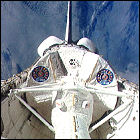 Returning to space after nearly a year of refits, Space Shuttle Columbia lifts off on the long-delayed first manned mission of the Spacelab laboratory module, which is installed in the cargo bay. (The nearly month-long delay was the result of a solid rocket booster issue that led to the first-ever return of the shuttle from the launch pad to the Vehicle Assembly Building.) The ten-day mission also boasts the first six-person shuttle crew, featuring the first Spacelab scientists from the European Space Agency, who have been training for this mission since the 1970s. Columbia’s crew includes Commander John Young, Pilot Brewster Shaw, mission specialists Owen Garriott and Robert Parker, and ESA payload specialists Byron Lichtenberg and Ulf Merbold.
Returning to space after nearly a year of refits, Space Shuttle Columbia lifts off on the long-delayed first manned mission of the Spacelab laboratory module, which is installed in the cargo bay. (The nearly month-long delay was the result of a solid rocket booster issue that led to the first-ever return of the shuttle from the launch pad to the Vehicle Assembly Building.) The ten-day mission also boasts the first six-person shuttle crew, featuring the first Spacelab scientists from the European Space Agency, who have been training for this mission since the 1970s. Columbia’s crew includes Commander John Young, Pilot Brewster Shaw, mission specialists Owen Garriott and Robert Parker, and ESA payload specialists Byron Lichtenberg and Ulf Merbold.
Space Shuttle: A Journey Into Orbit
 Activision releases the Space Shuttle cartridge for the Atari 2600 home video game system, an attempt to do a realistic flight simulator on limited hardware. Many of the console’s option switches – normally used to toggle difficulty levels, color or black & white graphics, and so on – are used for in-game functions instead.
Activision releases the Space Shuttle cartridge for the Atari 2600 home video game system, an attempt to do a realistic flight simulator on limited hardware. Many of the console’s option switches – normally used to toggle difficulty levels, color or black & white graphics, and so on – are used for in-game functions instead.
Soyuz T-10-A: launch pad disaster
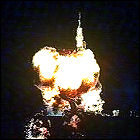 For the first time in history, a launch abort escape system saves its crew from a doomed launch. When a fuel spill is ignited at the base of the launch vehicle for Soyuz T-10-A – an otherwise routine mission to Soviet space station Salyut 7 – the entire rocket catches fire, and ground controllers quickly discover that cables running from their bunker to the vehicle have been severed, preventing them from remotely activating the launch escape tower. A radio frequency backup system finally sends the signal, and the tower blasts the Soyuz capsule free of its doomed rocket just two seconds prior to a massive explosion on the pad. The capsule brings the crew to a safe, but rough, landing a few miles away, while the launch pad fire burns out of control for nearly a day.
For the first time in history, a launch abort escape system saves its crew from a doomed launch. When a fuel spill is ignited at the base of the launch vehicle for Soyuz T-10-A – an otherwise routine mission to Soviet space station Salyut 7 – the entire rocket catches fire, and ground controllers quickly discover that cables running from their bunker to the vehicle have been severed, preventing them from remotely activating the launch escape tower. A radio frequency backup system finally sends the signal, and the tower blasts the Soyuz capsule free of its doomed rocket just two seconds prior to a massive explosion on the pad. The capsule brings the crew to a safe, but rough, landing a few miles away, while the launch pad fire burns out of control for nearly a day.
STS-8: first African-American in space
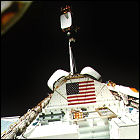 Taking off on a six-day satellite deployment mission, Space Shuttle Challenger also lifts the first African-American astronaut into orbit. A satellite deployment is carried out for India, along with continuing experiments to observe the performance of the shuttle in conditions of extreme cold with limited exposure to the sun. Aboard Challenger for this flight are Commander Richard Truly, Pilot Daniel Brandenstein, and mission specialists Dale Gardner, Guion Bluford, and William Thornton.
Taking off on a six-day satellite deployment mission, Space Shuttle Challenger also lifts the first African-American astronaut into orbit. A satellite deployment is carried out for India, along with continuing experiments to observe the performance of the shuttle in conditions of extreme cold with limited exposure to the sun. Aboard Challenger for this flight are Commander Richard Truly, Pilot Daniel Brandenstein, and mission specialists Dale Gardner, Guion Bluford, and William Thornton.
Salyut 7’s debris strike
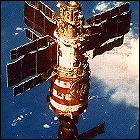 A small object hits one of the windows aboard the Soviet Union’s Salyut 7 space station, leaving a noticeable dent on its exterior layer but not causing enough damage to vent the station’s atmosphere into space (luckily for resident cosmonauts Vladimir Lyakhov and Aleksandr Aleksandrov, who might have to evacuate in their Soyuz T-9 vehicle in such an emergency). Though speculations include a micrometeoroid or wayward debris from a previous space mission, the exact cause of the impact is never confirmed.
A small object hits one of the windows aboard the Soviet Union’s Salyut 7 space station, leaving a noticeable dent on its exterior layer but not causing enough damage to vent the station’s atmosphere into space (luckily for resident cosmonauts Vladimir Lyakhov and Aleksandr Aleksandrov, who might have to evacuate in their Soyuz T-9 vehicle in such an emergency). Though speculations include a micrometeoroid or wayward debris from a previous space mission, the exact cause of the impact is never confirmed.
Soyuz T-9
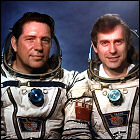 Soyuz T-9 lifts off from the Soviet Union, bringing a new long-term crew to space station Salyut 7. Cosmonauts Vladimir Lyakhov and Aleksandr Aleksandrov take up residence on Salyut 7 for a 150-day stay, including work aboard the recently-docked Kosmos 1443 temporary space station module. The disastrous failure of the next Soyuz mission to reach orbit means that Lyakhov and Aleksandrov spend their entire stay in orbit with no visits from other crews. They return to Earth on November 23rd.
Soyuz T-9 lifts off from the Soviet Union, bringing a new long-term crew to space station Salyut 7. Cosmonauts Vladimir Lyakhov and Aleksandr Aleksandrov take up residence on Salyut 7 for a 150-day stay, including work aboard the recently-docked Kosmos 1443 temporary space station module. The disastrous failure of the next Soyuz mission to reach orbit means that Lyakhov and Aleksandrov spend their entire stay in orbit with no visits from other crews. They return to Earth on November 23rd.
STS-7: first American woman in space
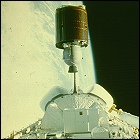 The second flight of Space Shuttle Challenger is a six-day mission to launch two more communications satellites (one for Canada and one for Indonesia), as well as featuring the first American woman in space (20 years behind the Soviet Union’s launch of Valentina Tereshkova). Challenger’s crew for this flight consists of Commander Robert Crippen, Pilot Frederick Hauck, and mission specialists John Fabian, Sally Ride and Norm Thagard.
The second flight of Space Shuttle Challenger is a six-day mission to launch two more communications satellites (one for Canada and one for Indonesia), as well as featuring the first American woman in space (20 years behind the Soviet Union’s launch of Valentina Tereshkova). Challenger’s crew for this flight consists of Commander Robert Crippen, Pilot Frederick Hauck, and mission specialists John Fabian, Sally Ride and Norm Thagard.
Soyuz T-8
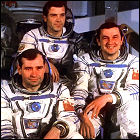 Soyuz T-8 lifts off from the Soviet Union, intended to dock with space station Salyut 7. Cosmonauts Vladimir Titov, Gennady Strekalov and Aleksandr Serebrov are due to take up residence on the station, but discover that the ejection of the nose cone of the Soyuz rocket – which protects the non-aerodynamic Soyuz vehicle during launch – has caused critical damage to the vehicle’s communication equipment. The mission is called off for safety reasons, and the crew returns to Earth after only two days.
Soyuz T-8 lifts off from the Soviet Union, intended to dock with space station Salyut 7. Cosmonauts Vladimir Titov, Gennady Strekalov and Aleksandr Serebrov are due to take up residence on the station, but discover that the ejection of the nose cone of the Soyuz rocket – which protects the non-aerodynamic Soyuz vehicle during launch – has caused critical damage to the vehicle’s communication equipment. The mission is called off for safety reasons, and the crew returns to Earth after only two days.
STS-6: Challenger’s first flight
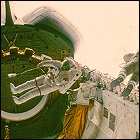 Space Shuttle Challenger lifts off into orbit for the first time, after extensive technical and mechanical issues keep the shuttle on the pad well past its original January launch date. The payload for this flight is NASA’s own TDRS (Tracking & Data Relay Satellite), designed to keep the shuttle in constant contact with ground controllers even if its orbit takes it out of direct communications. The five-day flight also sees the first spacewalk of the shuttle program. Challenger’s crew consists of Commander Paul Weitz, Pilot Karol Bobko, and mission specialists Donald Peterson and Story Musgrave.
Space Shuttle Challenger lifts off into orbit for the first time, after extensive technical and mechanical issues keep the shuttle on the pad well past its original January launch date. The payload for this flight is NASA’s own TDRS (Tracking & Data Relay Satellite), designed to keep the shuttle in constant contact with ground controllers even if its orbit takes it out of direct communications. The five-day flight also sees the first spacewalk of the shuttle program. Challenger’s crew consists of Commander Paul Weitz, Pilot Karol Bobko, and mission specialists Donald Peterson and Story Musgrave.
Kosmos 1443
 The Soviet Union launches an unmanned module, Kosmos 1443, on a trajectory that will bring it to the Salyut 7 space station for an automated docking. Once connected to Salyut 7, Kosmos 1443 provides extra habitable space for experiments and storage. A hardware holdover from the abandoned Almaz military space station program of the early 1970s, Kosmos remains docked to Salyut 7 through August 1983, at which time it is undocked and jettisoned, falling out of orbit and burning up in Earth’s atmosphere in September.
The Soviet Union launches an unmanned module, Kosmos 1443, on a trajectory that will bring it to the Salyut 7 space station for an automated docking. Once connected to Salyut 7, Kosmos 1443 provides extra habitable space for experiments and storage. A hardware holdover from the abandoned Almaz military space station program of the early 1970s, Kosmos remains docked to Salyut 7 through August 1983, at which time it is undocked and jettisoned, falling out of orbit and burning up in Earth’s atmosphere in September.
STS-5
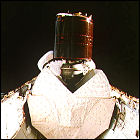 On the first fully-operational flight of NASA’s Space Transportation System, Space Shuttle Columbia delivers two commercial satellites to orbit, the Canadian Anik C-3 satellite and an American satellite, SitS-C. Aboard Columbia for this flight is the first four-astronaut crew in NASA’s history, consisting of Commander Vance Brand, Pilot Robert Overmyer, and mission specialists Joseph Allen and William Lenoir. The flight lasts five days before a landing at Edwards Air Force Base.
On the first fully-operational flight of NASA’s Space Transportation System, Space Shuttle Columbia delivers two commercial satellites to orbit, the Canadian Anik C-3 satellite and an American satellite, SitS-C. Aboard Columbia for this flight is the first four-astronaut crew in NASA’s history, consisting of Commander Vance Brand, Pilot Robert Overmyer, and mission specialists Joseph Allen and William Lenoir. The flight lasts five days before a landing at Edwards Air Force Base.
Soyuz T-7
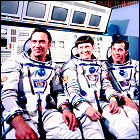 The Soviet Union’s Soyuz T-7 mission lifts off from Baikonur Cosmodrome for a week-long stay in space, including a visit to space station Salyut 7. The three-person Soyuz crew includes the first woman in space since 1963. Cosmonauts Leonid Popov, Aleksandr Serebrov and Svetlana Savitskaya deliver supplies to Salyut 7 and perform experiments while docked to the station; on August 27th, they depart from the station aboard the Soyuz T-5 vehicle, leaving the newer T-7 capsule for the station crew’s use.
The Soviet Union’s Soyuz T-7 mission lifts off from Baikonur Cosmodrome for a week-long stay in space, including a visit to space station Salyut 7. The three-person Soyuz crew includes the first woman in space since 1963. Cosmonauts Leonid Popov, Aleksandr Serebrov and Svetlana Savitskaya deliver supplies to Salyut 7 and perform experiments while docked to the station; on August 27th, they depart from the station aboard the Soyuz T-5 vehicle, leaving the newer T-7 capsule for the station crew’s use.
Salyut 6 falls to Earth
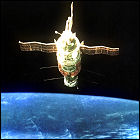 The Soviet Union’s Salyut 6 space station, unoccupied for over a year, re-enters Earth’s atmosphere with the Kosmos 1267 module still docked; both the station and its added module disintegrate over unpopulated ocean.
The Soviet Union’s Salyut 6 space station, unoccupied for over a year, re-enters Earth’s atmosphere with the Kosmos 1267 module still docked; both the station and its added module disintegrate over unpopulated ocean.
“The test flights are over”
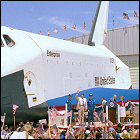 Space Shuttle Columbia lands at Edwards Air Force Base in California, making its first-ever landing on a concrete runway. After greeting the returning astronauts and inspecting the shuttle, President Ronald Reagan – with the partially-dismantled prototype Enterprise as a backdrop – declares NASA’s Space Shuttle system fully operational, saying “the test flights are over.” Columbia Commander Ken Mattingly later reveals that there was tremendous pressure on NASA to land Columbia on Independence Day, regardless of how many mission objectives had been met, to maximize the publicity value of the President’s speech. But the quick turnaround time and almost-weekly flight schedule that NASA had publicized throughout the 1970s is already a pipe dream: post-mission the four missions flown so far prove that post-landing servicing of each orbiter takes longer than expected. Columbia won’t fly again until the first “operational” mission in November.
Space Shuttle Columbia lands at Edwards Air Force Base in California, making its first-ever landing on a concrete runway. After greeting the returning astronauts and inspecting the shuttle, President Ronald Reagan – with the partially-dismantled prototype Enterprise as a backdrop – declares NASA’s Space Shuttle system fully operational, saying “the test flights are over.” Columbia Commander Ken Mattingly later reveals that there was tremendous pressure on NASA to land Columbia on Independence Day, regardless of how many mission objectives had been met, to maximize the publicity value of the President’s speech. But the quick turnaround time and almost-weekly flight schedule that NASA had publicized throughout the 1970s is already a pipe dream: post-mission the four missions flown so far prove that post-landing servicing of each orbiter takes longer than expected. Columbia won’t fly again until the first “operational” mission in November.
Challenger rollout
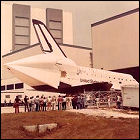 Completely refitted from a lightweight airframe originally fabricated for stress, vibration and thermal testing, Space Shuttle Challenger is rolled out of her Rockwell International assembly plant in Palmdale, California. Experience gained in the construction of Challenger’s sister ship, Columbia, means that the second completed shuttle in the fleet is over one ton lighter than Columbia. Challenger would make her first flight in just under a year.
Completely refitted from a lightweight airframe originally fabricated for stress, vibration and thermal testing, Space Shuttle Challenger is rolled out of her Rockwell International assembly plant in Palmdale, California. Experience gained in the construction of Challenger’s sister ship, Columbia, means that the second completed shuttle in the fleet is over one ton lighter than Columbia. Challenger would make her first flight in just under a year.
STS-4
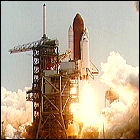 Space Shuttle Columbia lifts off for the fourth and final shuttle “test flight” before NASA’s Space Transportation System is declared fully operational. Remaining in orbit for a full week, Commander Ken Mattingly and Pilot Henry Hartsfield deliver the shuttle program’s first payload for the Department of Defense, as well as some of the first student-submitted experiment packages flown in the shuttle program. Both of Columbia’s solid rocket boosters, which are considered a reusable part of the launch vehicle, are lost at sea when their parachutes fail to deploy after separation and the boosters slam into the Atlantic Ocean; neither of the rockets are able to be recovered.
Space Shuttle Columbia lifts off for the fourth and final shuttle “test flight” before NASA’s Space Transportation System is declared fully operational. Remaining in orbit for a full week, Commander Ken Mattingly and Pilot Henry Hartsfield deliver the shuttle program’s first payload for the Department of Defense, as well as some of the first student-submitted experiment packages flown in the shuttle program. Both of Columbia’s solid rocket boosters, which are considered a reusable part of the launch vehicle, are lost at sea when their parachutes fail to deploy after separation and the boosters slam into the Atlantic Ocean; neither of the rockets are able to be recovered.
Soyuz T-6
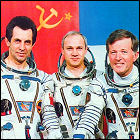 The Soviet Union launches the Soyuz T-6 mission on a week-long flight into orbit, including a visit to space station Salyut 7. Cosmonauts Vladimir Dzhanibekov, Aleksandr Ivanchenkov and Jean-Loup Chretien – the latter being the first Frenchman in space – spend several days aboard Salyut 7 performing experiments. Chretien would fly on later missions aboard Mir and the American Space Shuttle.
The Soviet Union launches the Soyuz T-6 mission on a week-long flight into orbit, including a visit to space station Salyut 7. Cosmonauts Vladimir Dzhanibekov, Aleksandr Ivanchenkov and Jean-Loup Chretien – the latter being the first Frenchman in space – spend several days aboard Salyut 7 performing experiments. Chretien would fly on later missions aboard Mir and the American Space Shuttle.
BOR4: the mini-shuttle that almost was
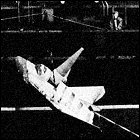 The Soviet Union launches a scaled-down test model of a compact space shuttle design into orbit, part of an ultimately abandoned study of a vehicle design called Spiral. The BOR4 structural test article is photographed being recovered from the Indian Ocean by the Australian government, revealing the design to the western world for the first time. NASA begins a study of the BOR4 lifting body design, finding that it has a stable flight profile and unusually good reentry and landing characteristics, and though NASA’s version of the vehicle, HL20, is later mooted as a shuttle replacement, both countries’ space agencies pass on the design, which will later be revived by Sierra Nevada Corporation as the Dream Chaser. BOR4 is launched three more times through 1984, at which point the Soviets instead press ahead with development of Buran, a near-exact copy of the American Space Shuttle.
The Soviet Union launches a scaled-down test model of a compact space shuttle design into orbit, part of an ultimately abandoned study of a vehicle design called Spiral. The BOR4 structural test article is photographed being recovered from the Indian Ocean by the Australian government, revealing the design to the western world for the first time. NASA begins a study of the BOR4 lifting body design, finding that it has a stable flight profile and unusually good reentry and landing characteristics, and though NASA’s version of the vehicle, HL20, is later mooted as a shuttle replacement, both countries’ space agencies pass on the design, which will later be revived by Sierra Nevada Corporation as the Dream Chaser. BOR4 is launched three more times through 1984, at which point the Soviets instead press ahead with development of Buran, a near-exact copy of the American Space Shuttle.
Soyuz T-5
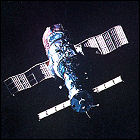 Soyuz T-5 lifts off from the Soviet Union, carrying its crew of two to the new Salyut 7 space station for a long-term stay. Cosmonauts Anatoli Berezovoy and Valentin Lebedev become Salyut 7’s first occupants, remaining aboard the station for a record-setting 211 days (almost seven months), not returning until December 1982. During that time, the two cosmonauts host two other visiting crews and launch a small amateur radio communications satellite by ejecting it from a small airlock.
Soyuz T-5 lifts off from the Soviet Union, carrying its crew of two to the new Salyut 7 space station for a long-term stay. Cosmonauts Anatoli Berezovoy and Valentin Lebedev become Salyut 7’s first occupants, remaining aboard the station for a record-setting 211 days (almost seven months), not returning until December 1982. During that time, the two cosmonauts host two other visiting crews and launch a small amateur radio communications satellite by ejecting it from a small airlock.
Salyut 7
 The Soviet Union launches the last of the Salyut space stations, Salyut 7, into Earth orbit. Reflecting an ongoing significant rethink on space station construction, Salyut 7 is intended from the outset to be docked with additional modules to expand its habitable and working space. It also sets a new endurance record of its own, remaining in orbit for nearly a decade.
The Soviet Union launches the last of the Salyut space stations, Salyut 7, into Earth orbit. Reflecting an ongoing significant rethink on space station construction, Salyut 7 is intended from the outset to be docked with additional modules to expand its habitable and working space. It also sets a new endurance record of its own, remaining in orbit for nearly a decade.